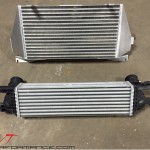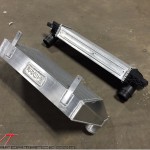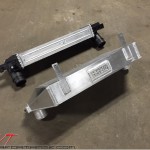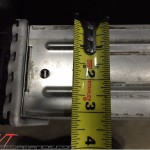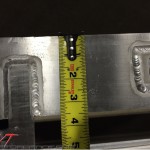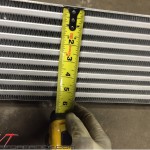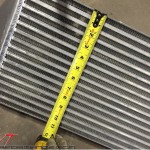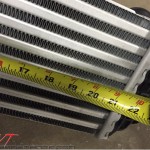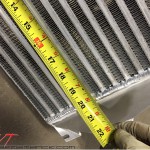Full Frontal
Revolution Automotive revs up its EcoBoost project with bolt-ons
By Steve Turner
Photos courtesy of Full Race Motorsports and Revolution Automotive
With the arrival of the EcoBoost option, the Mustang has a factory turbocharger again. As we know, OE power adders open the door to easy modifications much wider. Just ask owners of Terminators and GT500s. Even the mid-’80s SVO had upgrade parts available, but its viability as a modded car was overshadowed by the bolt-on friendly 5.0-liter V-8.

While today’s 5.0-liter certainly gets most of the headlines because it takes to modifications like a duck to water, the EcoBoost Mustang presents the most legitimate case for another version of the Mustang to modify that we have had in a long time.
That’s definitely what Revolution Automotive’s Dasan Holloway had in mind when he picked up his 2015 Mustang EcoBoost. Soon, he and Rev Auto’s main man Adam Browne put together a plan to boost the car’s performance with some well-chosen mods and a healthy dose of Adam’s tuning prowess via SCT Performance software and hardware.
The foundation of this phase of modifications was a larger, more efficient intercooler to lower and stabilize the turbo discharge temperatures. Doing so will allow for performance that is both increased and more consistent. With that in mind, the Rev Auto team turned to the Ford EcoBoost experts at Full Race Motorsports.

“Full-Race began working with prototype EcoBoost engines in 2010. We began by developing prototype turbo kits for the 3.5 F-150 EcoBoost and 2.0-liter Focus ST/Fusion,†Geoff Racier, Mechanical Engineer, Designer, and CEO at Full Race, said. “This 2.0-liter program was later turned into the Mustang twin-scroll.â€
Since that time, Full Race has rolled out a number of products for EcoBoost Fords, and they event built a sweet EcoBoost Mustang for last year’s SEMA Show that featured an upgraded turbo kit and more. Part of that kit is a new intercooler, which Rev Auto chose for its Mustang project, as the factory turbo can quickly heat soak and deliver discharge temps 50 to 70 degrees above ambient.

“The Full-Race intercooler is very consistent, and under the identical conditions we have seen 15 to 20 degrees max above ambient,†Geoff added. “Cooler air is more dense and improves combustion while lowering EGT. There is no performance benefit to hot charge-air temps on a turbo engine.â€
In addition to the intercooler, the Rev Auto crew also replaced the factory downpipe with a high-flow unit from Woodbine Motorsports. So, with cooler inlet temps and a freer flowing exhaust, Dasan’s Mustang just needed a calibration.
“From a tuning perspective there weren’t that many changes, I turned off the Active Grille Shutter enable switch since it gets deleted with the Full Race intercooler, and I also made some minor tweaks to the torque tables and adjusted for the high flow exhaust,†Adam explained.
With the new cal in the PCM, Adam hit the dyno and could immediately see the fruits of his labors. The larger Full Race intercooler was definitely doing work.

“From there we just let the intercooler do its job. Comparing the stock intercooler to the Full Race after two back-to-back pulls. The stock intake air temps started at 129 degrees and rose to 170 degrees during a Fourth-gear pull,†Adam added. “The Full Race intercooler started at 93 degrees and only rose to 111 degrees; also on a Fourth-gear pull. Both runs were made at operating temperature and from 2,000 to 6,000 rpm.â€
The cooler temps allowed Adam to get a bit more aggressive with the timing.

“This allowed for increased ignition timing (average of 2 degrees and more consistent power. Since the intake air temps were stable we never reached a temp where the ECU started pulling timing,†Adam said. “The next move is to further refine the combination at the track. There is still a lot of unlocked potential in the calibration. We have been doing R&D on our auto car and another manual EcoBoost car to make sure we have both sorted.â€
Yes, tuning the new Mustangs—especially the EcoBoost versions—is a tough task. The programming is far more complex. There are more tables to adjust, and some of the factory tables are still hidden from aftermarket tuners. However, with the mods and Adam’s tune installed, it was time to hit the track, and the results were quite promising.

“The EcoBoost Mustang is a very straight forward car to drive at the track. You do have to hold the e-brake to get the car to leave under any boost though,†Dasan said of his modded ride. “Although we are still working on the calibration the car managed to run a 12.6 at 107 on 93 octane while closing the throttle body to limit the power.â€
It should be interesting to see how well this car runs as Adam further refines the cal to keep that throttle open, but for now keep reading to see the mods added to Dasan’s Mustang.








